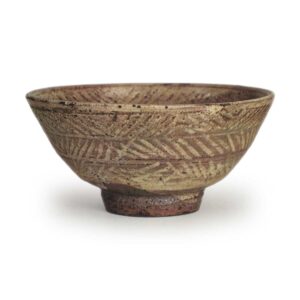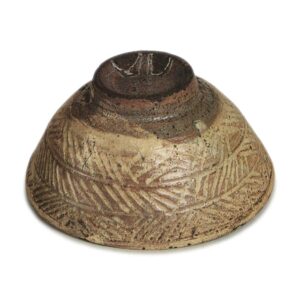

Held in the Hatakeyama Memorial Museum
Height: 7.0-7.1 cm
Diameter: 14.7-14.8 cm
Base diameter: 5.5 cm
Height: 1.2-1.4 cm
The Taisho Meiki Kan (A Guide to Famous Tea Bowls of the Taisho Period) lists six bowls by Chōzanshima as being superior to the others: Yaegaki, Sotobana, Arahana, Higakaki, Zansetsu, and Chōzanshima. There are not many Chōmishima tea bowls that have a warm, soft feel like this one, and it is also unusual that the whole bowl is tinged with a reddish color close to flesh color.
The clay is a rough soil with a little iron content and sand mixed in, and a slightly thick layer of transparent glaze is applied to the entire inside and outside. The firing is not very strong, so the bottom and the foot of the bowl are semi-translucent, giving it a moist feel.
The shape is a shallow bowl with a flat rim, supported by a large bamboo-joint foot. The bowl is thick and solid. On the outside, there are three rows of the so-called hinoki-gaki pattern, which is carved diagonally with a tool, and on the inside, there are two rows of hinoki-gaki pattern around the rim, and seven flower patterns around the inside, and on top of that, there are thirteen flower patterns in a two-rowed pattern, and the flower patterns and the hinoki-gaki patterns inside and outside are inlaid with white clay. The white inlay is made by applying white clay to a red clay base, rubbing it with a damp cloth, and then filling in the carved lines and flower patterns with white clay, while wiping off the white clay from the rest of the surface. However, since the white clay is not completely wiped off, there are places where the white clay is faintly visible on the waist and inside the surface, and this also becomes part of the scenery of this teacup.
Since Chōmishima is fired in a reducing or neutral flame, many of the finished pieces are a dark blue or a reddish gray, but this Chōmishima is fired in an oxidizing flame, so the whole piece is tinged with red. Even though it has a reddish tinge, it is not a plain red color, and there are also parts with a light gray color around the foot, and there are also areas with a light blue tinge on the body, so there are various shades of red, and the fact that it has a complex variation is also one of the charms of this teacup.
It is rare for a Chawan to be entirely reddish in color, and because the firing is slightly underdone, it has a soft, moist feel. The inside has a dent in the tea pool, and there are eight marks around it. There are also some loose threads around the rim, which are called “mushikui”, and there are two channels.
In addition, there are two finger marks on the underside of the bottom and next to the tatami mat. This is because the entire inside and outside is covered in glaze, so when the tea bowl is dipped into the glaze jar, the finger marks from the thumb around the rim are covered up by the glaze and cannot be seen.
The inner box is black lacquered with red trim, and the outer box is paulownia wood. There is a note by Matsudaira Fumai that says “Chozan Mishima tea bowl” in five characters.
This tea bowl was passed down in the Unshu Matsudaira family, and in the Unshu Zocho (Unshu Treasury Book), it is listed as “Chozan Mishima” in the famous tea bowls section.



